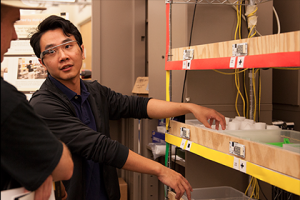|
Mental health issues are considered to be socially stigmatized in the society. Consequently, too many individuals, finding a trusted individual whom they can confide to regarding their mental illness is a grave challenge. It has been established that online communities provide a powerful platform for candid disclosures and support seeking around stigmatized concerns and experiences. Online health support groups in Reddit, in particular, due to their semi-anonymity feature, have established an extensive support platform for people with social inhibitions seeking help. |
Visualizing sets to reveal relationships between constituent elements is a complex representational problem. Recent research presents several automated placement and grouping techniques to highlight connections between set elements. However, these techniques do not scale well for sets with cardinality greater than one hundred elements. We present OnSet, an interactive, scalable visualization technique for representing large-scale binary set data. |
In our research, we leverage ideas from citizen science and the open science movement to create an infrastructure for facilitating partnerships between volunteer STEM workers and social movement organizations. Towards this goal, we will do action research with the nonprofit organization Science for the People (SP). Science for the People engages in research, activism, and science communication for the betterment of society and the environment. |
|
|
Over the past year, we have collaborated with researchers at Morehouse School of Medicine and students recruited from several universities and community-based organizations in Georgia to form a network of young adult Peer Champions to promote COVID-19 vaccination in their communities, with a focus on Black and Latinx Georgians. |
Where should a head worn display (HWD) be placed for optimal viewing? Does the optimal position change between reading, working on a physical task like order picking, or social conversation? How do we test such issues? Our ongoing studies on user comfort and performance suggest the optimal placement is somewhere between 10 and 20 degrees off-center toward the ear. |
For this project, we are working with a AAA gaming studio (Insomniac Games) to investigate how adults with and without disabilities customize their console gaming experiences and their motivations behind these decisions. We are interested in the design and presentation of in-game settings, barriers to accessing these settings, and ways to encourage players to change the necessary settings to improve their experience. This project will follow a human-centered design process through user interviews, surveys, diary studies, and additional methods to be determined. |
OptoSense is a ubiquitous Imaging Surface which conforms to everyday objects, harvests energy from ambient light, and senses a variety of human activities without compromising privacy. By leveraging organic semiconductor (OSC) optoelectronics with thin & flexible form factor, large-area compatibility, and highly customizable characteristics, we aim to develop distributed imaging technologies for human activity sensing which truly “weaves” into fabrics of everyday life. |
|
Warehouses throughout the world distribute approximately $1 trillion in goods per year from nearly a million warehouses. Order Picking is the process of collecting items from inventory and sorting them into orders for distribution. It represents one of the main activities performed in warehouses. About 60% of the total operational costs of these warehouses is order picking. Most are still picked by hand, often using paper pick lists.  |
OrderUp! takes health-related gaming in a new direction and seeks to educate players about how to make healthy eating choices in situations nearly everyone encounters regularly in their lives. By casting players as virtual restaurant servers, OrderUp! forces players to make healthy and fast menu decisions for a group of demanding, impatient customers. OrderUp! was originally developed as a simple, casual game on Nokia N95 mobile phones.  |
Data visualization systems have predominantly been developed for WIMP-based direct manipulation interfaces. Only recently have other forms of interaction begun to appear, such as natural language or touch-based interaction, though usually operating only independently. Prior evaluations of natural language interfaces for visualization have indicated potential value in combining direct manipulation and natural language as complementary interaction techniques. Unfortunately, however, little work has been done in exploring such multimodal visualization interfaces.  |
"Our Driverless Futures" is a web-based interactive narrative that critically examines the ethical implications of self-driving cars. In public and scholarly discourse, self-driving cars are often positioned as safer and more efficient transportation alternatives, with one prominent debate remaining in their programming: how should they react in an inevitable fatal accident, and whose lives should they prioritize to save? However, this focus on "kill decisions" has limited the terms of discourse to utilitarian ethics and normative classifications of people. |
|
Informing the planning of hikes and trail walks through immersive experiences right from your screen at home. |
Alone in a strange and dark forest, you find a lantern, your sole source of light and comfort. But soon you are joined by two characters, and each makes a compelling argument as to why you should give the lantern to them. Who do you trust? You decide! This virtual reality experience places you at the penultimate moment of Cartoon Network's Emmy-award winning "Over the Garden Wall" mini-series.  |
In collaborative human-robot assembly tasks, the robot will need to identify important elements of a scene (humans, objects) and understand their behavior and interaction. Estimated skeleton and object interaction information are often used for video-based human activity recognition, but most research focuses on depth sensors. There are many more standard RGB cameras and videos in the world, but unreliability of pose/object estimations hinders their adoption in this domain. We present novel techniques for dealing with such unreliability to aid in adoption of these techniques for RGB sensors. |


